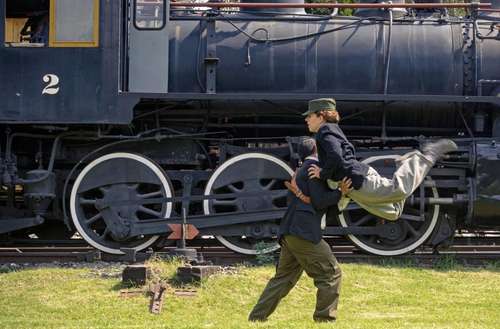The social practices that emerged from the use of the railroad throughout history are explored through 11 interdisciplinary staging. Train: Between the earth as in the body It is a project of the National Center for the Preservation of the Railroad Cultural Heritage (Cnppcf), and is part of the activities that the National Railroad Museum organizes around the means of transport that humanity has been using for almost 200 years.
“We have addressed the issue of the railroad and especially what has to do with its social bond and the collective memory that arises from individual stories,” explained Teresa Márquez, director of the Cnppcf.
Multidisciplinary project
The multidisciplinary project is focused on the practices and phenomena that occur today. Thus, the 11 video dances that make up Train: Between the earth as in the body They address issues such as migration and the practices that arise around mobility by means of the train as a means of transport.
Rocío Becerril, coordinator of the staging, explained that for her project she sought artists from various states of the Mexican Republic. Thus, in 2015 he began to work with the idea of elaborating a work that truly reflected the interdisciplinary nature of Train: Between the earth as in the body.
“Not only is it that the work has dance, video, but there was really a process of collaboration, of listening, which are the elements that really sustain an interdisciplinary community,” said the visual artist.
Performers participate in the assembly of the R + R Art and Movement Company: Clementina Guadarrama, Araceli Mendoza, Andrea Garay, Miranda Santa María, Jazzmin Pantle, Bereniz Pantle, Carlos Ramírez, Carlos Rojas, Rocío Becerril, Angélica Baños and Francisco Alarcón. In addition to Rocío Becerril, Carlos Rojas was in charge of the choreography.
For Becerril, the results obtained have been satisfactory thanks to this collaborative process. “Behind there is a fabric that is sustained by the ideas, bodies and interactions of various people,” said Rocío in recognition of the work that her colleagues developed.
Despite the pandemic, the coordinator said she was happy to be able to carry out the staging. Thanks to the help of institutions such as Fonca, or the support of UNAM in three recordings of video dances, the multidisciplinary artists who participate have managed to enjoy “the joy of being able to live such a process, with resources that are necessary.”
The first time the show was staged it was also done in a particular context, as they had to adapt it due to the effects caused by the 2017 earthquake. The dances were staged outside the National Railway Museum, and thanks to the will of the organizers and the assimilation capacity of the multidisciplinary artists, it could also be carried out.
To move Train: Between the earth as in the body to a digital format, it was necessary to go through a new approach process that involved scripts and experimentation. However, thanks to their digital version, the pieces have been able to reach people in countries that they otherwise would not have been able to reach.
“The performing artists are accepting that we have to change our production logic, the same scripts, even the same interpretation,” Becerril said about the changes they have experienced due to the current health crisis.
Train: Between the earth as in the body It is made up of 11 video dances, an animation video, which was included at the end, and pieces by the plastic artist Rodrigo Flores, with whom Rocío Becerril worked on the development of the project.
Each of the dances has its own narrative in which poetry, history or plastic art can be found. The influence that the railroads have had was also noted in the works of figures such as José Revueltas, Arqueles Vela or María Zambrano, from whom some staging draws inspiration.
The staging has been divided into a trilogy that has already begun to be published on Facebook and YouTube of the Railway Museum. Mind, machine and memory, Blessed and Secrets Y Daydreams These are the three parts in which the dances have been organized, they will be available on the Contigo en la Distancia platform and will continue to be available for later consultation.
–

:quality(85)//cloudfront-us-east-1.images.arcpublishing.com/infobae/IKJZ3U2XGVGI5O5YCG3SUMIHMM.png)
